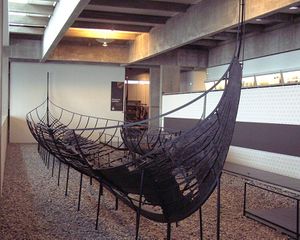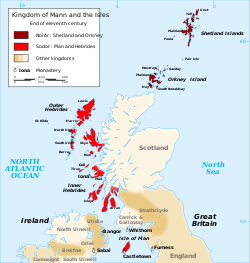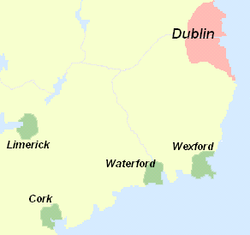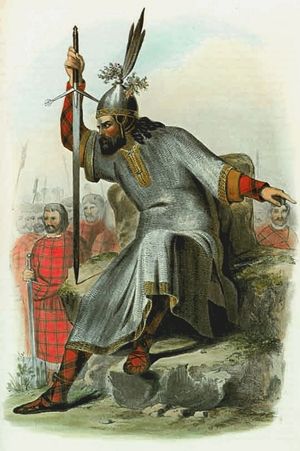نورس-غال
النورس-غال (قالب:Lang-sga؛ Irish: Gall-Ghaeil؛ غالية اسكتلندية: Gall-Ghàidheil, 'foreigner-Gaels'؛ إنگليزية: Norse–Gaels) كانوا شعباً مختلط الأصل والثقافة من Gaelic و Norse. وقد ظهروا في عصر الڤايكنگ، حين Vikings who استقروا في أيرلندة و في اسكتلندة adopted Gaelic culture and intermarried with Gaels. The Norse–Gaels dominated much of the البحر الأيرلندي و Scottish Sea regions من القرن التاسع إلى القرن الثاني عشر. وقد أسسوا مملكة الجزر (which included the Hebrides and the جزيرة مان)، مملكة دبلن، لوردية گالواي (which is named after them), and ruled the مملكة يورك لبعض الوقت. The most powerful Norse–Gaelic dynasty were the Uí Ímair أو بيت آيڤار.
Over time, the Norse–Gaels became ever more Gaelicized and disappeared as a distinct group. However, they left a lasting influence, especially in the Isle of Man and Outer Hebrides, where most placenames are of Norse–Gaelic origin. العديد من العشائر الاسكتلندية لها جذور نورسية-غالية، مثل عشيرة مكدونالد، عشيرة مكدوگل، Clan Ruaidhrí و عشيرة مكلاود. The elite mercenary warriors known as the gallowglass (gallóglaigh) emerged from these Norse–Gaelic clans and became an important part of Irish warfare. The Viking longship also influenced the Gaelic birlinn أو longa fada, which were used extensively حتى القرن السابع عشر. Norse–Gaelic surnames survive today and include MacIvor, MacAskill, MacAuley and (Mac)Cotter.
الاسم
The Norse–Gaels are also sometimes called the Norse-Irish and Norse-Scots.
التاريخ

The Norse–Gaels originated in Viking colonies of Ireland and Scotland, the descendants of intermarriage between Norse immigrants and the Gaels. As early as the 9th century, many colonists (except the Norse who settled in Cumbria) intermarried with native Gaels and adopted the Gaelic language as well as many Gaelic customs. Many left their original worship of Norse gods and converted to Christianity, and this contributed to the Gaelicisation.
انظر أيضاً
- Caill Tomair, a sacred grove near Dublin targeted by Brian Boru in the year 1000
- يورك الاسكندناڤية
- Old English (Ireland)
- عشيرة دونالد
- إرل أوركني
- Gallowglasses
- ملوك دبلن
- قائمة حكام مملكة الجزر
- Diocese of Sodor and Man
- Galley
- Lord of the Isles
- Lords of Galloway
- Papar
الهامش
ببليوگرافيا
- Downham, Clare (2009). "Hiberno-Norwegians and Anglo-Danes". Mediaeval Scandinavia 19. University of Aberdeen. ISSN 0076-5864.
{{cite book}}: CS1 maint: location missing publisher (link) - Haywood, John (1995). The Penguin Historical Atlas of the Vikings. London: Penguin. ISBN 0-14-051328-0.
- McDonald, R. Andrew (1997). The Kingdom of the Isles: Scotland's Western Seaboard, c. 1100 – c. 1336. East Linton: Tuckwell Press. ISBN 1-898410-85-2.
- Ó Cróinín, Dáibhí (1995). Early Medieval Ireland, 400–1200. London: Longman. ISBN 0-582-01566-9.
- Oram, Richard (2000). The Lordship of Galloway. Edinburgh: John Donald. ISBN 0-85976-541-5.
- Scholes, Ron (2000). Yorkshire Dales. Derbyshire: Landmark. ISBN 1-901522-41-5.
وصلات خارجية
- Articles containing غالية اسكتلندية-language text
- Pages using Lang-xx templates
- Articles containing إنگليزية-language text
- Articles containing أيرلندية-language text
- CS1 maint: location missing publisher
- Portal-inline template with redlinked portals
- Pages with empty portal template
- نورس-غال
- Medieval ethnic groups of Europe
- الجماعات العرقية في أيرلندا
- الجماعات العرقية في اسكتلندا
- Manx society
- الامبراطورية النرويجية
- Viking Age in Ireland
- Scandinavian Scotland


